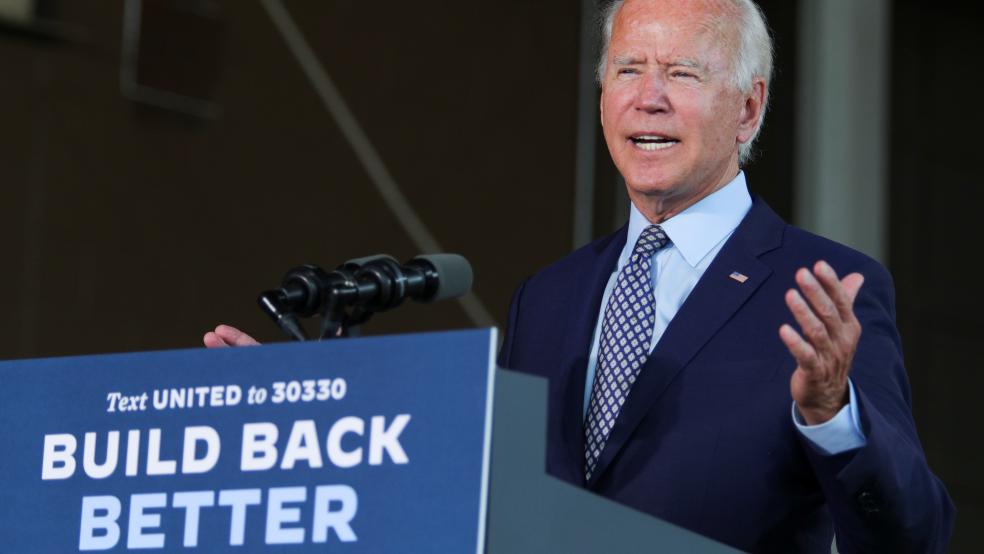A newly updated analysis from the conservative American Enterprise Institute finds that Joe Biden’s tax plan would raise roughly $2.8 trillion over 10 years, while reducing economic growth by a modest 0.16%.
Biden has proposed raising taxes on corporations and the wealthy to pay for increased spending on a wide variety of public programs. The tax hikes include raising the corporate tax rate; reversing some elements of the 2017 Republican tax cuts for households earning more than $400,000 per year; and taxing capital gains and dividends as ordinary income for taxpayers who report more than $1 million in income.
Who pays more: Overall, Biden’s tax plan would make the U.S. tax system more progressive, AEI’s Kyle Pomerleau and Grant Seiter say.
Businesses would see the biggest effects. “Most of the new revenue in Biden’s tax plan would come from increased business taxes ($1.9 trillion),” they write. “The largest source of new business revenue and the largest source of new revenue in the entire plan is the proposal to raise the corporate tax rate from 21 percent to 28 percent ($1 trillion between 2021 and 2030).”
On the individual side, the tax hikes would fall almost entirely on the wealthy. “In 2021, Biden’s tax proposals would increase the tax burden on the top 5 percent of households and reduce the tax burden on the bottom 95 percent of households,” the report says. The top 1% would see their incomes reduced by 14.2%, while taxpayers in the bottom 94% of the distribution would see after-tax incomes climb by between 0.5% and 11.3%, with those in the bottom decile seeing the largest increase.
After 10 years, all households would pay slightly higher taxes, although this outcome is produced by assumptions AEI makes about corporations’ ability to pass tax hikes along to workers and consumers — assumptions that are contested by the Biden campaign and some tax experts.
Higher GDP in the long run: The AEI analysis finds that GDP would be slightly smaller after 10 years relative to the baseline, though that conclusion is due in large part to the assumption built into the model that higher taxes reduce labor supply and capital stock in the economy. Even so, in the second decade, Biden’s plan produces slightly higher GDP relative to the baseline, the analysts said, “because the increased tax revenue decreases the trajectory of US debt, which means more household savings can be used for private capital accumulation and less has to be used to service the debt interest.”
Spending plans not included: In addition to tax hikes, Biden has proposed huge increases in spending on a wide variety of social programs, but those aren’t included in the AEI analysis. However, it’s the combination of the two — a big fiscal boost from increased social spending backed by higher taxes on businesses and the wealthy – that have led many economists, including analysts at Moody’s and Goldman Sachs, to conclude that Biden’s plans would provide more economic growth than the grab-bag of proposals from the Trump campaign. “Largely because of Biden’s substantially more expansive fiscal policies, the economy would return to full employment more quickly coming out of the pandemic than under Trump,” analysts at Moody’s wrote last month.
No support for President Trump’s wild claims: Writing about the AEI report Wednesday, Tory Newmyer of The Washington Post noted that, “President Trump says Joe Biden’s tax plan would bring about a depression and destroy the country. Independent studies have found no support for that claim. And the latest, an updated examination of the Biden proposal from the right-leaning American Enterprise Institute, should drive a stake through it.”
But it’s largely theoretical in any case: Digging into the details of the AEI analysis, The Wall Street Journal’s Richard Rubin pointed out that some elements of Biden’s proposed changes to the tax code will be politically contentious, among both Democrats and Republicans. “[W]ill there be enough votes in Congress for all of those tax increases?,” he asked. In the end, an analysis of revenue increases “adjusted for political reality looks much smaller,” he said.




